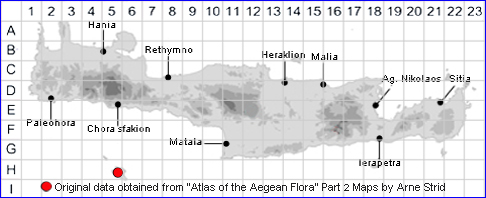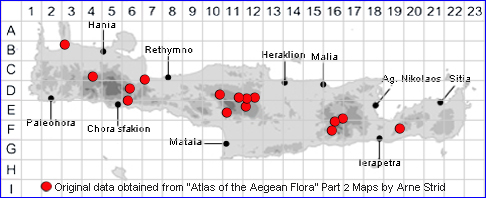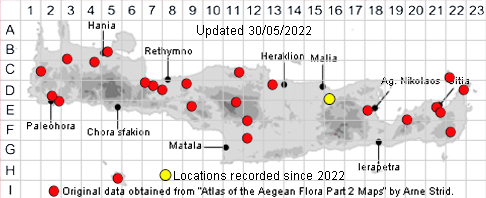SPECIES DESCRIPTION
RUMEX PULCHER
Including the following four subspecies:-
Family and Genus:- See- POLYGONACEAE/Subgen. RUMEX
Common Names:- None
Homotypic Synonyms:- None
Meaning:- Rumex (L) A name used by the Roman naturalist and philosopher Pliny
for sorrel.
Pulcher (L) Rolled up, crowded.
General description:- Perennial, often papillose.
Stem:-
1) 20-60 cm tall usually single, with stiff, ± divaricate branches.
Leaves:-
1) Ovate-oblong, often somewhat panduriform, subcordate to cordate at the base.
with, obtuse, flat or with slightly undulate margins.
a) lower, blade, usually 4-9 cm.
b) basal, small, fleshy.
Flowers:-
1) Inflorescence, of several in dense, remote whorls, usually of more than 4., with
leaf-like bracts in the lower part.
2) Pedicels, short, usually thickened.
Fruit:-
1) Fruiting valves, 4.5-6 x 2.5-4,5 mm of various shapes, with a network of raised
tuberculate veins.
Key features:-
1) Flowers, in whorls of more than 4.
2) Pedicels, stout, equalling or shorter than the valves, articulated near the middle
3) Leaves, mostly less than 10 cm, usually panduriform.
a lower not more than 3½ times as long as wide.
4) Stems, strongly divaricate.
Habitat:- Seasonally damp spots in scrubland vegetation, roadsides, olive groves,
rudral habitats. 0-800(-1500) m.
Distribution:- Throughout Greece. -Widespread in W Europe, the Mediterranean
region, Anatolia and Caucasus, naturalized in North America, Australia and
lsewhere; very variable.
Flowering time:- Apr-June.
Photos by:- Steve Lenton

~~~~~~~~~~~~~~~~~~~~~~~~~~~~~~~~~~~~~~~~~~~~~~~~~~~~
RUMEX PULCHER subsp ANODONTUS Back to Top
Homotypic Synonyms:- None
Meaning:- Anodontus (Gr) With outward-pointing teeth.
Resembling Rumex pulcher, but differering in the following characters:
1) Valves, 4-5 mm, narrowly ovate-triangular, entire or with 1 or 2 teeth up to 0·5
mm near the base
Habitat:- Seasonally damp spots in scrubland vegetation, roadsides, olive groves,
rudral habitats. 0-800(-1500) m.
Distribution:- Scattered in the Mediterranen region and SW Asia. Rare on Crete
known from only from the island of Gavdos.
Flowering time:- Apr-June.
~~~~~~~~~~~~~~~~~~~~~~~~~~~~~~~~~~~~~~~~~~~~~~~~~~~~
RUMEX PULCHER subsp PULCHER Back to Top
Homotypic Synonyms:- None
Resembling Rumex pulcher, but differering in the following characters:
1) Basal leaves usually panduriform. Branches angular-flexuous, often forming an
intricate mass.
2) Valves, 4-5 mm, narrowly ovate or oblong, with lingulate apex; 1 or 2 meshes of
venation on each side of the tubercle.
a) teeth, 1-2 mm, 4 on each margin.
Habitat:- Seasonally damp spots in scrubland vegetation, roadsides, olive groves,
rudral habitats. 0-800(-1500) m.
Distribution:- Mostly in the Aegean area, probably extending to Bulgaria and W
Anatolia. Rare on Crete known from only a few scattered locations.
Flowering time:- Apr-June.
Photos by:- Steve Lenton

~~~~~~~~~~~~~~~~~~~~~~~~~~~~~~~~~~~~~~~~~~~~~~~~~~~~
RUMEX PULCHER subsp RAULINII Back to Top
Homotypic Synonyms:-
Meaning:- Raulinii (L) Probably for Victor Raulin, French Botanist (1819-1905)
Resembling Rumex pulcher, but differering in the following characters:
1) Basal leaves, usually oblong to elliptic panduriform.
2) Branches, angular-flexuous, often forming an intricate mass.
3) Valves c. 6 mm; teeth 3-4 mm, 5 or 6 on each margin.
a) Spines, 14 mm long, usually 3-6 on each side 1-2 mm long.
Habitat:- Seasonally damp spots in scrubland vegetation, roadsides, olive groves,
rudral habitats. 0-800(-1500) m.
Distribution:- Mostly in the Aegean area, probably extending to Bulgaria and W
Anatolia. Rare on Crete known from only a few scattered locations.
Flowering time:- Apr-June.
Photos by:- Steve Lenton

~~~~~~~~~~~~~~~~~~~~~~~~~~~~~~~~~~~~~~~~~~~~~~~~~~~~
RUMEX PULCHER subsp WOODSII Back to Top
Homotypic Synonyms:-
Meaning:- Woodsii (L) For John Medley Wood (1827-1915) Curator of Durban
botanic Garden.
Resembling Rumex pulcher, but differering in the following characters:
1) Basal leaves, seldom panduriform.
2) Branches, arcuate-divaricate.
3) Valves, 4-5 mm, suborbicular or ovate-triangular, broadly acuminate at the apex,
usually 3 meshes of venation on each side of the tubercle;
a) teeth, 0·5-1 mm, up to 8 on each margin.
Habitat:- Seasonally damp spots in scrubland vegetation, roadsides, olive groves,
rudral habitats. 0-800(-1500) m.
Distribution:- Mostly in the Aegean area, probably extending to Bulgaria and W
Anatolia. Fairly rare on Crete known from only a few scattered locations.
Flowering time:- Apr-June.
Photos by:- Zacharias Angourakis
